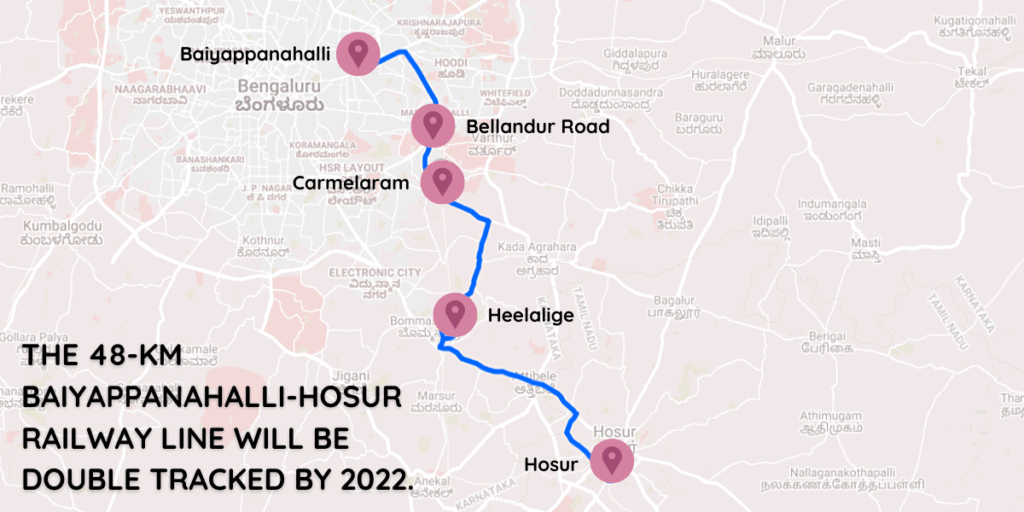In the short span of 10 days, around 600 citizens of Bengaluru sent an email to the Deputy Conservator of Forests (Bengaluru Urban), seeking an extension to send objections/suggestions to the double tracking of the Baiyappanahalli-Hosur railway line.
The double tracking project that will pan out over 48 km around Bengaluru is part of the Government of Karnataka’s special purpose vehicle Karnataka Rail Infrastructure Company (K-RIDE) developing a plan for the extension of the suburban railway network.
The double tracking project seeks to cut 1034 trees between Baiyappanahalli and Hosur. The forest department issued a public notice calling for objections and suggestions in accordance with the Karnataka Preservation of Tree Act. However, the citizens were only given 10 days for the same.
Read more: Doubling Baiyappanahalli-Hosur railway line: Boon or Bane?
The citizens were passed down the obligation of conducting surveys, informing local villagers and engaging the ward committees.
During this process, we realised that 10 days to conduct surveys, engage with local villagers, the local flora and fauna were not even close to being adequate.
This alignment will be along the Yeshwantpur bypass, Hebbal, Banaswadi, Bellandur, Heelalige, Anekal Road and Maranayakanahalli.

The city has become predominantly urban, and a 2017 study by the Indian Institute of Science showed a decline of 88% of its green space from 1973 to 2017.
At a time where our collective future is in question because of collapsing biodiversity, we need more than 10 days’ time to assess the impact of further destruction to our neighbourhood.
We understand the importance of the suburban railway and how crucial it will be to boost the public transport system in Namma Bengaluru.
However, unplanned development has wreaked havoc in the city. In the past, the development that followed the ORR made it a mutated land corridor.
The residential layouts had to be dependent on the IT parks to accommodate the increasing population that came with the Outer Ring Road (ORR). The rural back roads remained the same causing disturbance to the huge apartments and the rapid commercialisation.
This was due to a lack of planning and proper public consultation.
Read more: India urgently needs urban forests. What’s stopping us from creating more?
It is pertinent to engage citizens in the process that will directly impact them. To enable this, Jhatkaa.org launched a campaign asking concerned citizens of Bengaluru to seek an extension to submit the suggestions/objections.
By April 8, 2021 around 600 concerned citizens had sent an email to the Deputy Conservator of Forests (Bengaluru Urban) seeking an extension to the deadline so that meaningful suggestions or objections can be sent.
Even before the initial consultation period was over, illegal cutting of trees outside Heelalige Railway Station was reported.
This signals the complete disinterest of agencies to respect the public consultation period. The collective concerns have gone unheard on the ears of the forest department and the state government in the past.

Just last year, citizens reported illegal road projects around Bengaluru for a road expansion project by Karnataka Road Development Corporation Limited (KRDCL).
KRDCL had proposed the felling of over 8000 trees without prior environment clearance under the EIA (Environment Impact Assessment) Notification, 2006, in absence of Forest Clearance under the Forest (Conservation) Act, 1980, and in absence of prior recommendation of the Standing Committee of National Board for Wildlife (SC-NBWL) under the Wildlife (Protection) Act, 1972.
As a result, the entire project is illegal and “there is no remedy available under the law to make it legal ex post facto”.
This accelerates our concerns and the strong need for a democratic and participatory process to the developmental plans of the city.
Read more: Is the axing of 5,000 trees for road widening around Bengaluru justified?
We have also seen a significant increase in the approval of forest clearance rates. Less than one per cent of the forest clearance proposal was rejected by the Ministry of Environment, Forest and Climate Change (MOEFCC). A drastic increase since 2014. Deforestation has become the norm instead of the exception.
The draft EIA of 2020 also made a provision to reduce the time period for the public to submit their responses during a public hearing for any application from 30 days to 20 days. Public consultation is being reduced to a mockery.
Now more than ever is the time to improve the public consultation process. This is also the first time a suburban railway project is being launched, and it is different from a regular road, flyover or underpass project.
Citizens of Bengaluru agree that when the tree population per person ratio is poor and the city has around 1 tree for every 7 persons, adequate time needs to be provided to assess the impact of projects and submit meaningful suggestions or objections, if any.
[This article is based on a campaign run by Jhatkaa.org, a non-profit campaigning organisation committed to building grassroot citizen power across India in effective and innovative ways]
There shud be compensation by planting X nos. of Miyawaki forests which I believe come up fast.